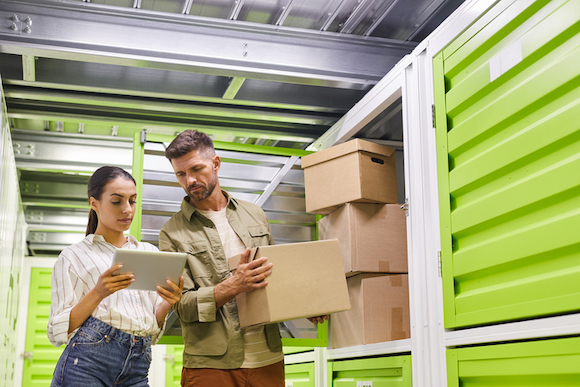Planning a move involves juggling a lot of tasks – and it’s not easy.
“Almost 100 percent of customers that come to us reiterate that moving is really hard,” said Emma Gordon, storage specialist at Clutter, an on demand storage company.
Storing some or all of your belongings when moving can reduce some of the stress involved with the transition. In other situations, you may have no choice but to store your items temporarily. For example, if your new home isn’t ready and you have to leave your current home now.
Below are just a few scenarios during which you may need temporary storage between moves.
When Should I Use Storage During a Move?
- For moves with short notice, storage can add some leeway to your plans. Keep your belongings in a storage unit while staying with family or friends until you find a new place.
- If you are selling a house, staging it may help you sell it more quickly and for more money. Move the bulk of your items to a storage facility so the home stager has free reign to spruce up your digs.
- If your new home is a fixer-upper, you may need to keep your stuff in temporary storage until all of the renovations are done.
- Another time storage can help ease the stress of moving—incorporating travel into your move. If you take a job opportunity in a new city or state, put your household items in storage. This makes it easy to take a trip abroad or travel within the U.S. before starting your new job.
Temporary Storage Options
When moving, there are a few different short term storage solutions to consider. Weigh the cost and convenience of each option available to you in order to make a decision.
- Self-storage facility. A self-storage facility is an affordable option for keeping your items safe between moves. Contracts are month to month, so storage units are ideal for short term storage or long term storage. A wide range of storage sizes can accommodate your household goods, no matter how big your home is. A big benefit of self-storage is you can access your items anytime.
- On demand storage. This modern method is as easy as ordering an Uber. Helpers will come to your home, pick up your stuff and take it to a secure facility. When you are ready to retrieve your items they will deliver them back to you. These services can get pricy, especially if you have a lot of items to store. Some have a commitment of three months. On demand storage is ideal if you just have a few possessions you need to keep until you can get into your new place, and don’t have your own vehicle to get them to a storage unit yourself.
- Portable storage. Also known as moving pods, portable storage containers can be kept on your property for as long as you need it, or stored at the company’s warehouse until you are ready for delivery. This method is very convenient, as the container is delivered to you and you load it on site. Storage costs can be quite expensive, so it is not ideal for long-term storage. The big benefit is that portable storage containers can be moved across country. However, the fees are considerably more compared to renting a moving truck and doing it yourself. Popular portable moving container companies include PODS, U-Haul, Zippy Shell and U-Pack.
- Storage in transit. If you have tapped a full service moving company for a long-distance move, they can usually arrange for storage in transit. This means that they load up all the items from your current home and will store it up to 90 days before delivering to your new address. Again, this option is typically quite expensive compared to storing items yourself.
- Friends and family. Storing your stuff with a friend or family member who is fortunate enough to have extra storage space is a viable option for your stuff if they live close by. Just don’t overstay your welcome or your relationship might sour.
What to Store
“It’s always best if the decision to store things rests on the value of the item in question,” said Lauren Williams, owner of Casual Uncluttering LLC in Woodinville, WA. Check if you can replace the item easily if you leave it behind, as well as if it will fit the new space.
If the item has sentimental value, such as a family heirloom or favorite piece of furniture, you might want to store it until you find the right spot for it. Boxes of photos, trophies, or other memorabilia might also work well in a storage unit. You’ll likely want those items, but won’t need them during the initial transition. If you store them in a place near your moving destination, you’ll be able to gather them when you’re ready.
Downsizing first before you move to your new home will reduce the amount of storage space you need rent. Get rid of any items that you no longer have a use for, or that can be easily replaced.
Find A Good Spot
If you’re looking for a storage location in the city or state you’re moving to, check for one that is near your new place.
“This will give you plenty of time to settle in and slowly bring your less needed items to your new house,” said Anna Horn, representative of NYC Mini Storage, an NYC based storage provider.
Compare prices to find the most cost-effective option for storing your household goods. Any storage facility will be happy to give you a free quote.
“As far as pricing goes, with more traditional storage it depends on the neighborhood and goes with property values,” said Gordon.
If don’t the prices you want in your neighborhood, try the next one over to see if the prices. They may be more in line with what you want to spend.
Reserve Ahead of Time
You’ll often be in a better situation if you check-in early. Book online ahead of time or call. Depending on the unit and the management, you might be put on a list and told when that particular unit becomes available.
If you just show up, there may be one or two units available, but you could get a smaller unit than you need, or a larger one than you want.
Most self-storage companies won’t let you reserve a self-storage unit more than 30 days ahead of time. But you can tour facilities and ask questions well before then. That way you are prepared to reserve as soon as the time comes.






